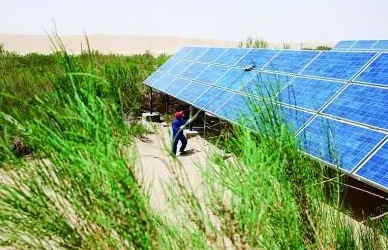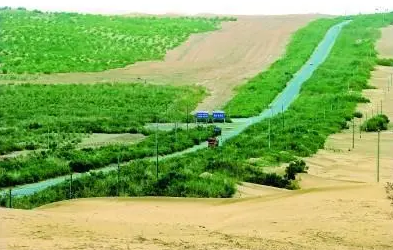
The poplar planted in the desert 20 years ago has now grown into a huge tree.

Forestry cultivation bases have been built in the desert hinterland to provide grass and tree species for highway greening projects.

Protect the highway from quicksand erosion with both grass squares and geotextile partitions.

Protect the highway from quicksand erosion with both grass squares and geotextile partitions.

Workers are laying drip irrigation pipes.

Workers are laying drip irrigation pipes.

After more than 20 years of construction, a green corridor has long been formed on both sides of the Taklamakan Desert Highway.
The Taklamakan Desert in Xinjiang, with a surface area of 330,000 square kilometers, is the largest desert in China and the second largest mobile desert in the world, and has been called the "Sea of Death" and the "Forbidden Zone of Life". It was not until the 1990s that large-scale oil exploration and development awakened this mysterious land. Builders not only built highways in this vast desert, but also created a green miracle that amazed the world.
The depths of the Taklamakan Desert are rich in oil resources, but how can large-scale machinery and equipment for exploration and development enter the desert hinterland? Extracted oil and gas and how to get out of the desert into the market? In front of these problems, the construction of a cross-desert highway became an inevitable choice. 1994, the oil road builders built a more than 500 kilometers through the desert north and south of the highway. Since then, the length of the highway has been continuously extended, and a branch road to ensure the development of oil and gas fields has also come into being.
In order to enable this long transportation line to gain a foothold in the flowing desert, a large-scale battle against sand has begun. In order to resist the erosion of the highway by the desert, the oil road builders adopted the sand fixing and greening measures. They first made up the hay into a square implanted in the desert, radiation highway on both sides of more than a hundred meters wide, and then with the geotextile in the middle of the grass square, forming a partition, and finally in the grass square on the planting of trees.
In order to ensure the survival rate of the forest, the researchers have screened more than 70 kinds of heat-resistant and sand-resistant plants after years of research and testing. After artificial domestication, four of them are fully capable of surviving in the harsh desert environment. After large-scale seeding, these surviving plants effectively slowed down the flow of desert on both sides of the highway, blocking the repeated attacks of quicksand on the highway.
Since 2003, the Taklamakan Desert Highway has been implementing the protection forest ecological project - planting more than 70-meter-wide forest belts on both sides of the main highway, with a total area of more than 3,500 hectares, and planting more than 20 million resistant tamarisks, shakojubes, pikes, and other excellent plants to prevent winds and fix sands; at the same time, a well is constructed at intervals of 10 kilometers in order to realize drip irrigation and watering.
After more than 20 years of efforts, a green corridor across the Taklamakan Desert has finally been built, which is a successful work of human governance of the desert. Today, the Taklamakan Desert has taken on a new look - a long black dragon surrounded by green forest belts stretching across the golden sand sea, and the endless flow of convoys gives the vast desert infinite vitality and vigor. At the same time, the oil and gas fields deep in the desert have become an important national energy production base, and the prosperity of the highway transportation industry has also effectively driven the economic development of the areas along the route, providing many conveniences for the people of Xinjiang